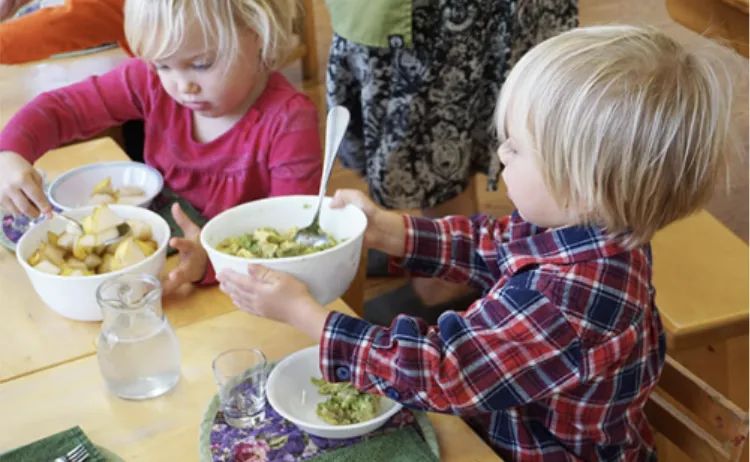
The Habit of Sharing
Wouldn't it be great if sharing was just a habit for our kids! In this blog we show you how to help your child create a new habit... the habit of sharing food with others at mealtimes.
_________________________________________________________________________________
Did you know that young children show an innate eagerness to help, but not to share*!?
...which is all the more reason why we probably need to put a bit more effort into helping our kids develop sharing tendencies (preferably in early childhood) - coz it don't come so natural it seems! That doesn't mean forcing them to share because this can sometimes result in kids developing a scarcity mindset and being even less inclined to share as they get older.
So what can we do? As always, the earlier in childhood that we begin, the better.
One of the best ways of promoting sharing tendencies is by attempting to satisfy our kids' basic psychological needs (the need for Autonomy, Competence and Relatedness) while they are engaged in any degree or form of sharing. (See Lesson 7 in our Foundations Program for a detailed account of how to do this). This strategy has been most strongly associated with wellbeing outcomes for kids, across a range of domains**. In this blog, however, we're interested in helping kids to develop the habit of sharing.
In the emerging science of habit formation^, habits can be newly created by turning up the dial, so to speak, on the 'four laws' of creating ANY new habit: 1. make it obvious, 2. make it attractive, 3. make it easy, and 4. make it satisfying. So, let's apply this to ... hmmm... let's say - helping kids develop the habit of sharing food at mealtimes, ...at the table.
Firstly, ...
AVOID just putting their food on ‘their’ individual plate, placing their plate in front of them and then going back to the kitchen bend. (Unless your child is a baby!)
INSTEAD, follow the 4 laws of creating new habits. Start by cutting up a little more food than you’d planned to, or dividing what food you have into smaller parts, then:
1. make it obvious that you and your child will share the food you're placing on the table; arrange or spread out the food items in serving bowls or on a board and place these in the 'communal' space in the centre of the table; put empty plates where you and your child (and anyone else) will sit;
(Yes this involves taking time out of your day to sit and eat with your child, but you don’t need to do it for every meal! Just as often as you can. As your child slowly develops the habit of effortlessly sharing food with family members and perhaps later with friends, you’ll be glad you devoted the time early in your child’s life so that your whole family can enjoy the rewards later on).
2. make it attractive by using colourful and cute little bowls; you could use 'special' little serving spoons or tongs dedicated to ‘serving’ others and sharing out the food; lay out some cute placemats for both you and your child; [there’s a reason why many cultures ‘ritualise’ eating meals together and ensure the table and foods look attractive – it adds a whole other level of enjoyment to communal eating and sharing food together.]
3. make it easy for your child to serve others at the table by having the bowls or platters within their easy reach, and by choosing utensils that are easy to use; if they are having trouble, give your child clear and easy suggestions on how they can serve and share out the food between you; to begin with, you could just ask them to serve one easy thing (the potato mash?!) while you serve the rest – it needs to be easy, not hard. (You can build on the habit as it develops, but slowly... over time. Be patient. )
4. make it satisfying for your child to share food with you; give your child your full attention; be playful, show your eagerness to be served by them - ask for a bite of their carrot stick! show them your gratitude when they put food on your plate – perhaps blow a little kiss. Make sharing a fun and satisfying experience in whatever way you can.
If you have more than one child, just use this same strategy and let all your children take turns serving each other. Sometimes they will be greedy and serve themselves extra! – that’s normal. But use this opportunity to gently draw that child's attention to the needs and desires of the other people at the table - help them be more considerate of the others at the table and share more fairly. (But don't shame them! Be gentle but firm). They’ll get better at it over time!
Mealtimes in our house have always been an important time of the day for us, especially as our kids got older and became teens and ... for some reason didn't want to spend as much time with us during the day! 🤔 Nevertheless, they always emerged at dinner time and our meals were leisurely and full of conversation - oh and - the sharing of food! I'm SO glad we insisted on eating together every night and sharing our food together. I don't think I realised at the time (when they were young) how beneficial this simple habit would be for them as they grew older.
I hope this blog has been helpful and... happy sharing (of food!) with your kids.
______________
*Lancy, D. F. (2020). Child helpers: A multidisciplinary perspective. Cambridge University Press.
**Lataster, J., Reijnders, J., Janssens, M. et al. Basic Psychological Need Satisfaction and Well-Being Across Age; Journal of Happiness Studies, 23, 2259–2290 (2022). https://doi.org/10.1007/s10902-021-00482-2
An Easy & Proven Way to Build Good Habits & Break Bad Ones; Avery Press. https://jamesclear.com/atomic-habits
The Power of Habit: Why We Do What We Do in Life and Business; Random House

